

Gold or green: which is the best shade of open access? Going for gold is the solid approach, argues Michael Mabe...but David Price counters that only green is sustainable Gold standard just right in the 'Goldilocks zone' Michael Mabe hails the Finch report's consensus-building and its pragmatic support for the 'pay-to-publish' open-access model Dame Janet Finch has my admiration and my sympathies.

Having recently chaired a European Union-funded research project involving groups with very different frames of reference and viewpoints, I understand the challenge she faced in building and retaining an open-access consensus. Make no mistake: the Finch report is a pragmatic compromise and an example in consensus-building. Not unexpectedly, voices have been raised in criticism from outside the Finch group.
Open Access Explained! Openness has won - now what? As we start the new year and survey the open education landscape, it's hard not to conclude that openness has prevailed.
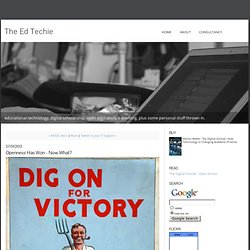
The victory may not be absolute, but the trend is all one way now - we'll never go back to closed systems in academia anymore than we will return to the Encyclopedia Brittanica. Whether it's open access publishing, open data, MOOCs, OERs, open source or open scholarship - the openness battle has largely been won. Time to rejoice! But, of course, it's never that simple. When it was simply open vs closed it was a clear distinction. In both cases things were better than the dark days, but they wouldn't be simple sweetness either. So it is with openness. We replace open vs closed with a set of more complex, nuanced debates, which are, to be honest, a bit boring for many. The use of OER for research methods teaching in social science and education. This is a SCORE funded project which explores ways of enhancing practice in research methods teaching through the use of open educational resources.
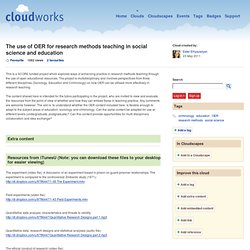
The project is multidisciplinary and involves perspectives from three different disciplines (Sociology, Education and Criminology) on how OER can be utilised more effectively in research teaching. The content shared here is intended for the tutors participating in the project, who are invited to view and evaluate the resources from the point of view of whether and how they can embed these in teaching practice. Any comments are welcome however. The aim is to understand whether the OER content included here is flexible enough to adapt to the subject areas of education, sociology and criminology. Can the same content be adapted for use at different levels (undergraduate, postgraduate)? Extra content Resources from iTunesU (Note: you can download these files to your desktop for easier viewing) Nordic Journal of Digital Literacy goes Open Access - idunn.no - Nordic journals online. From volume 5, 2010 Nordic Journal of Digital Literacy goes Open Access.
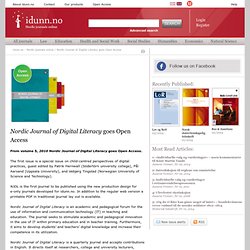
The first issue is a special issue on child-centred perspectives of digital practices, guest edited by Patrik Hernwall (Södertörn university college), Pål Aarsand (Uppsala University), and Vebjørg Tingstad (Norwegian University of Science and Technology). NJDL is the first journal to be published using the new production design for e-only journals developed for idunn.no. In addition to the regular web version a printable PDF in traditional journal lay out is available. 9780262517638_Open_Access_PDF_Version. Library-OAReport.pdf. Business, Innovation and Skills Committee: Written evidence submitted by Tony Hey.
I am giving my opinion based on my experience as a UK academic for 30 years, and as an ex-Head of Department and Dean of Engineering at the University of Southampton.
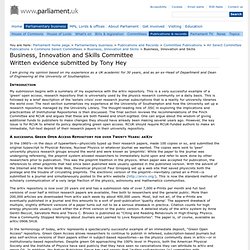
Introduction My submission begins with a summary of my experience with the arXiv repository. The Access/Impact Problem and the Green and Gold Roads to Open Access: An Update. Open access. Research publications that are distributed online, free of cost or other access barriers Open access (OA) is a set of principles and a range of practices through which research outputs are distributed online, free of cost or other access barriers.[1] With open access strictly defined (according to the 2001 definition), or libre open access, barriers to copying or reuse are also reduced or removed by applying an open license for copyright.[1] The main focus of the open access movement is "peer reviewed research literature.

"[2] Historically, this has centered mainly on print-based academic journals. Whereas conventional (non-open access) journals cover publishing costs through access tolls such as subscriptions, site licenses or pay-per-view charges, open-access journals are characterised by funding models which do not require the reader to pay to read the journal's contents. Definitions[edit] Colour naming system[edit] Gold OA[edit] Green OA[edit] Comparing the Impact of Open Access (OA) vs. Non-OA Articles in the Same Journals.
(This Opinion piece presents the opinions of the author.
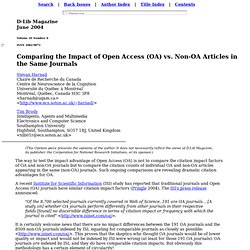
It does not necessarily reflect the views of D-Lib Magazine, its publisher, the Corporation for National Research Initiatives, or its sponsor.) The way to test the impact advantage of Open Access (OA) is not to compare the citation impact factors of OA and non-OA journals but to compare the citation counts of individual OA and non-OA articles appearing in the same (non-OA) journals. Such ongoing comparisons are revealing dramatic citation advantages for OA. A recent Institute for Scientific Information (ISI) study has reported that traditional journals and Open Access (OA) journals have similar citation impact factors (Pringle 2004). The ISI's press release announced: "Of the 8,700 selected journals currently covered in Web of Science, 191 are OA journals... What further needs to be compared is: Figure 1. Access is not a sufficient condition for citation, but it is a necessary one. Figure 2. Figure 3. References Note 1. Business Models and Funding » Introduction There are a range of business models available to support Open Access and in turn institutional repositories and journals.

Open Access the key to ivory towers. Content by UTS Peer-reviewed research is increasingly being made available online for free.

Photo: Photo by Thinkstock. It is one of the greatest challenges so far to the claim that academics live in ivory towers. Peer-reviewed research from academics at the University of Technology, Sydney (UTS) will soon be available to the general public, free of charge, on iTunes, the so-called jukebox software used to download music, film and book files.
The change pitches academic research a long way from the traditional 12 to 18-month publication process that locks up research papers in expensive journals that are only available to the academic institutions that can afford to pay for them. The innovation, which will see academically peer-reviewed material in video form and video with images and text, placed in one downloadable container, is part of a much longer, world-wide trend known as open access. Advertisement “No publishers anywhere else are doing this,” says Booth about the iTunes move. Open Access. Gold and green: the routes to open access.